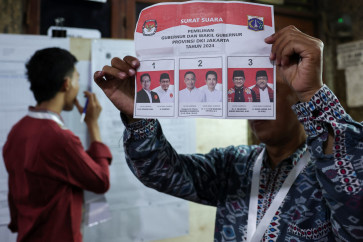Popular Reads
Top Results
Can't find what you're looking for?
View all search resultsPopular Reads
Top Results
Can't find what you're looking for?
View all search resultsAfter Oecusse Airport, Wika eyes more in Timor Leste
Passengers of a Citilink Indonesia flight from Jakarta stared in amazement as two red firetrucks showered their aircraft with a water cannon salute, welcoming the first international flight to ever land at Oecusse in Timor Leste
Change text size
Gift Premium Articles
to Anyone
P
assengers of a Citilink Indonesia flight from Jakarta stared in amazement as two red firetrucks showered their aircraft with a water cannon salute, welcoming the first international flight to ever land at Oecusse in Timor Leste.
As the passengers headed to the exit, hundreds of Timorese gathered at the seaside airport to witness a historic event for their country: Timor Leste President Francisco Gutteres’ inauguration of Oecusse Rota do Sandalo International Airport, located in the remote coastal enclave of the Oecusse Special Administrative Region, which is surrounded by Indonesian West Timor.
Formerly known as Palaban Airport, the once-small airstrip has been transformed into a modern and sleek-looking airport by an Indonesian state-owned construction firm, PT Wijaya Karya (Wika).
Wika president director Tumiyana said on Tuesday that it took the company about two years to complete the US$120 million project, which included a 2.2-kilometer-long runway and a passenger terminal that can accommodate about 500,000 people annually.
“This is our first-ever integrated airport construction project we have ever built,” he said to the press after the inauguration ceremony in Pante Macassar, Oecusse, Timor Leste. It was also the region’s first international airport and the biggest in Timor Leste, said Mari Alkatiri, a former prime minister who now serves as president of the Oecusse Special Administrative Region.
Other than being a new source of pride for the country, he said, the airport was also expected to bring foreign tourists and, in turn, private investment into the country.
Alkatiri said that currently the government was having talks with airlines from Hong Kong and Australia to arrange flights to the newly built airport.
The local government was also building a five-star hotel in Oecusse, while developing the region’s tourism through private investment.
“We want to develop our community tourism that can strengthen the identity of our people,” Alkatiri said, adding that investments in other sectors would come to the region.
President Gutteres said he also hoped that the airport could strengthen relations between Timor Leste and Indonesia, as well as bring peace, particularly with the neighboring region of East Nusa Tenggara.
Although the Rota do Sandalo Airport was the first integrated airport construction project it ever completed, Tumiyana said it was not Wika’s first project in Timor Leste.
Destiawan Soewardjono, the firm’s operational director who supervised overseas projects, said that the company had been involved in several of the country’s infrastructure projects since 2012, namely phase I and II of the Comoro Bridge, a diesel-fueled power plant in Hera and the Batugade-Maliana road that was connected to the immigration post in Belu Regency of East Nusa Tenggara, Indonesia.
All of those projects and the airport that Wika had completed, he said, were worth about $300 million, equal to about 11 or 12 percent of its overseas portfolio. However, the number of projects that the Indonesian construction giant was involved in represented just a fraction of the country’s planned infrastructure projects.
According to analysis by the Economist Intelligence Unit, Timor Leste has allocated $1.63 billion for state spending. About $704 million of the budget is to be used to develop the country’s infrastructure, which is almost double its 2018 infrastructure spending of $385 million.
The jump was driven by the government’s plan to diversify its economy as the country’s oil reserves are becoming depleted and petroleum production from active fields is projected to end in 2022, according to the International Monetary Fund. This means that the former Portuguese colony needs to find a new source of revenue other than oil in the near future.
As a way to achieve this, the government is trying to attract private investment into the country by making Oecusse a special economic zone (SEZ) similar to Indonesia’s Morotai SEZ in Central Sulawesi, so that it becomes a hub for industry, tourism, finance and agriculture that could attract more than $4 billion in investments by 2025.
Given the huge number of projects waiting to be developed in the country, Tumiyana said Wika was also open to investing in the country’s other infrastructure projects, one of them being the industrial estate that the government was planning to build.
However, he said, Wika had yet to determine the amount it could invest into that project.
“Once we have the details [of the projects], we’ll have to look at the potential and feasibility study results before determining how much the investment will be,” said Tumiyana.










